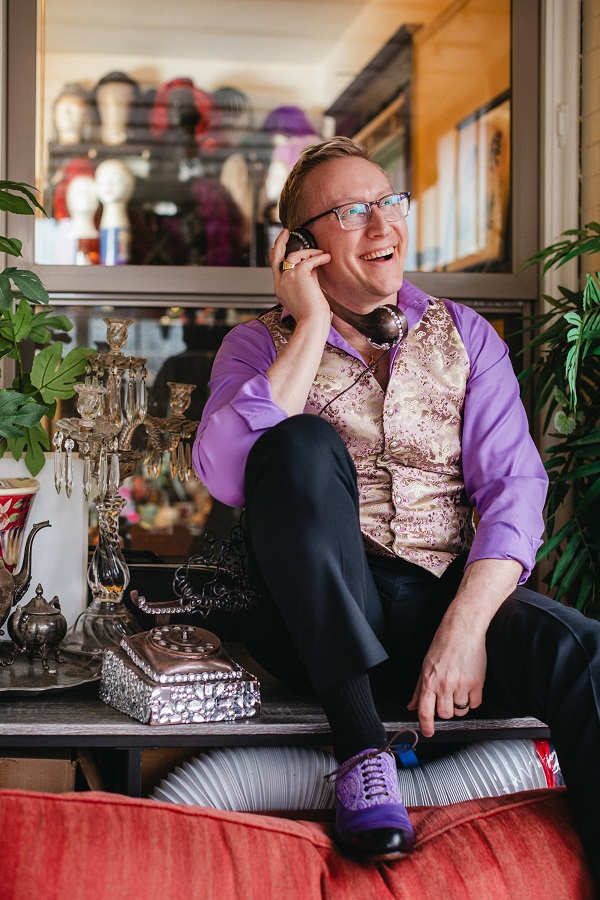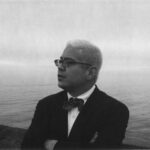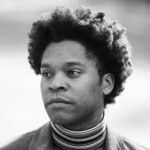An Invitation to David Saffert’s Fabulous Party
Written by Emma Marris; Photographed by Jason Quigley
David Saffert’s closet is packed with clothes—beautiful, glamorous, gaudy clothes. Beaded capes. Sequined jackets. Patriotic red, white, and blue hot pants. These are the costumes he has acquired during a decade of performing as Władziu Valentino Liberace–better known simply as Liberace.
By his death in 1987, Liberace was probably most famous for two things: his flamboyant stage costumes, and his adamant refusal to come out publicly as a gay man. But beyond the glitz and personal drama, there was a pianist who could undeniably put on a show. He played with a relaxed and happy self-confidence, delivering Gershwin medleys and Chopin Polonaises with assurance and style, and interspersing his musical numbers with carefully crafted stage patter that sounded warm and spontaneous. He loved fancy cars, fancy dogs, rhinestones, his mother, and the adulation of his fans. He claimed in a 1973 autobiography that he was on the road performing “thirty or forty weeks out of every year.” For Liberace, applause in Sheboygan was (almost) as thrilling as performing in London for the Queen.
Saffert hasn’t played for royalty (yet) but he has a lot in common with Liberace. They were both born in Wisconsin—Liberace in 1919, Saffert in 1975. They both trained as classical pianists, but were drawn to perform popular fare as well. They’re both five-feet-ten-inches. More fundamentally, they were both driven by a similar motivation. As Saffert puts it, “I want them to feel like they are special guests at a fabulous party.”
Saffert’s tribute act began when he was working on a variety show. Back then, Saffert spent most of his time playing piano for the Oregon Ballet Theatre, the Portland Opera, and other “highbrow institutions.” The variety show was his way of having a bit of fun, mixing high and lowbrow entertainment. He had seen Portland singer/actor/comedienne Jillian Snow perform as Liza Minnelli. “There are a lot of Liza impersonators who can’t do all of it. I mean, they’ll dress up. There’s a classic Liza wig you can buy. But that doesn’t mean you can sing New York, New York and Cabaret. And she can. She can sing your face off.” He wanted her in his show.
But Liza needed an accompanist. Saffert was game, but wasn’t sure if he wanted to accompany the Liza Minnelli as himself. A friend suggested Liberace—one of the few pianists who could rival Liza’s iconic stage presence.
Saffert didn’t know much about Liberace at the time. But thanks to the magic of YouTube, he was able to immerse himself in videos of Liberace’s classic performances. With his piano cluttered with candelabras and his hands emerging from frothy lace sleeves, Liberace was undoubtedly a hoot. But he also exuded genuine sweetness, something that immediately appealed to Saffert. “Here’s the most positive, warm, generous individual. Constantly smiling, you know, winking at you through the camera,” Saffert says. “He’s lovely! He just wants you to have fun.”
A Liberace show was not designed to challenge or provoke, to change minds or engage the audience with the knotty problems of the day. It was designed to wow and delight, to make the audience feel happy and safe.
Saffert realized that he was the right person for that job. Not only did he have the skills as a pianist, he had training and experience in acting, improv, sketch comedy and emceeing—all requirements to embody one of the greatest hams to ever tickle the ivories. In January 2014, the Liza and Liberace act was born.
Saffert studied everything about Liberace’s performances, from his jokes to his gestures. Because Liberace didn’t play with sheet music, Saffert had to recreate the arrangements himself, often watching multiple videos of each performance, looking for camera shots that showed Liberace’s hands at key moments. Then he had to embody Liberace’s stage persona. “After ten years, I can do it in my sleep,” Saffert says. “But the first couple years, I’m thinking: oh, make sure you wink!”
Saffert emphasizes that his act is a tribute, not an impersonation. Sure, there’s a little teasing, a little innuendo—how could you not?—but at its heart, Saffert’s act is not about making fun of Liberace. It is about celebrating him. Nothing makes this clearer than his reluctance to incorporate Liberace’s ill-advised foray into psychedelic rock in 1968 into his act, even though Liberace’s notably square delivery of “Hello young folks, what you shakin’?’” has become popular on TikTok. It would be funny, but you can tell Saffert feels protective of Liberace. Yes, Liberace was extremely campy. But Liberace knew it. It was part of the act. Whereas his cover of “Feelin’ Groovy” wasn’t campy on purpose. There’s a difference.














































